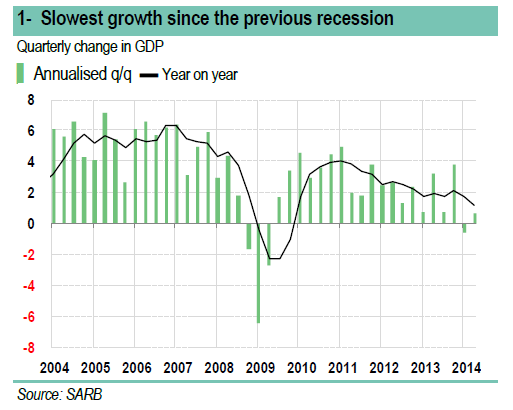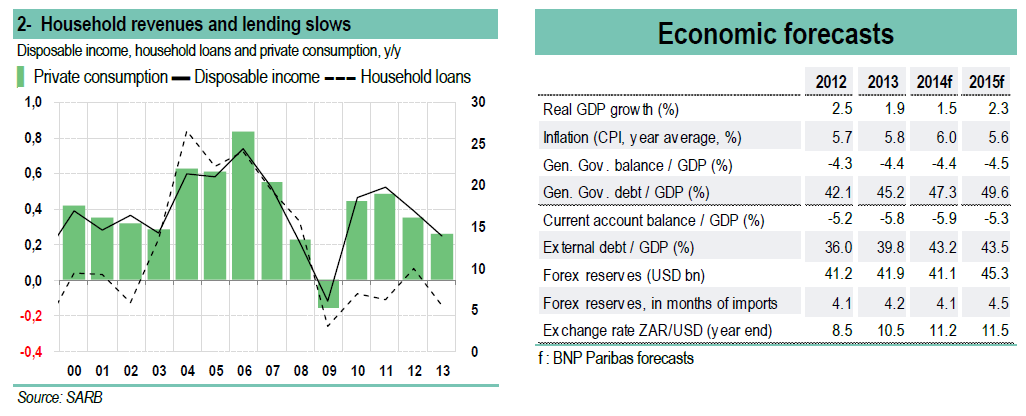Zuma’s re-election fails to break the downward spiral
South Africa’s economy continues to slump. Q2 GDP rebounded at an annualised quarterly rate of 0.6% (vs. -0.6% in Q1), but this was due solely to more growth in services. The primary and secondary sectors continued to contract (down 5.1% and 9.4%, respectively) after a Q1 performance devastated by strikes (-17.2% and -24.7%), including a platinum miners’ strike that was both the longest (23 January to 24 June) and most costly in the country’s history1. Year on year, GDP rose only 1.1%, even though imports contracted over the period (1.1% y/y). Exports have been hard hit (-12% annualised q/q; slowing to 3.1% y/y vs. 8.6% in Q1) for several reasons, both external (sluggish growth in Europe, slowdown among Asian trading partners) and domestic (production contracts due to strikes; lack of competitiveness despite the rand’s sharp depreciation).
Jacob Zuma’s re-election in May 2014 general elections did not foster the political change that the country needs to reassure investors. Extremely weak social-economic indicators (poverty, unemployment, high prevalence of HIV), shortfalls in public services (troubles accessing drinking water, public transport, waste management and insecurity) and a rigid job market have fuelled often violent protest movements. The social climate is still extremely tense following the brutal repression of the Marikana strike in August 2012. The regulatory environment was already complicated enough following the implementation of much needed positive discrimination laws on behalf of populations formerly disadvantaged by apartheid, but it is now the centre of a highly polarised political debate (for or against the nationalisation of mines, for example), making it unpredictable for non-resident investors. This is one reason why South Africa, despite its strong potential (not only in mining, but also with a domestic market of 50 million consumers), attracts relatively little foreign direct investment. Most of its current account deficit (6.2% of GDP in Q2, up sharply from 4.5% in Q1) is financed through portfolio investments, which is also one of the country’s structural macroeconomic vulnerabilities.

With wage costs rising faster than labour productivity (annual average of 7.5% and 2.8%, respectively, since 2011), higher import prices due to the rand’s depreciation (-40% against the dollar since early 2011) and the lacklustre outlook for demand, companies have been destocking massively since 2012. Even more alarming is the slowdown in investment – both public and private – which decelerated for the third consecutive quarter in Q2 2014 to its lowest growth rate in four years (annualised quarterly rate of 0.5%).
■ Private consumption: the last, fragile rampart against recession
At the end of H1, the South African economy benefited from acquired growth of only 1%. The ending of strikes in the mining and steel industries will certainly trigger an upturn in production in the primary and secondary sectors in H2. Yet unless demand materialises, the rebound risks being fairly anaemic. With faltering growth engines and persistently high budget deficits (4.5% of GDP in 2009-2013), the government has little manoeuvring room, which leaves private consumption as the last rampart against recession. Its contribution to the growth of domestic demand has risen from a little less than 60% over the period 2000-2012 to more than 90% since 2013. Yet consumption has also been slowing continuously since year-end 2011, dropping to 1.9% y/y in Q2, the slowest growth since the 2009 recession. Disposable household income slowed again in Q2 to an annualised quarterly rate of 1.3%, hampered by high inflation (6.2% y/y in the first eight months of the year, vs. 5.9% over the same period in 2013) and the first bout of monetary tightening: the central bank raised the repo rate by 50bp in January and by 25bp in July 2014 to 5.75%, the highest rate since end 2010. At the same time, the unemployment rate surged to 25.5% in Q2, the highest level since Q2 2011. After 449,000 job destructions during the recession (Q4 2008 to Q1 2010), the private sector created only 163,000 jobs between Q2 2010 and Q1 2014. Over the same period, the public sector created 257,000 jobs, but this momentum cannot be sustained over the medium term. Yet the country still has immense needs: Out of a working age population of 35.3 million, only 15.1 million had jobs in Q2. The other 57% were either unemployed (5.1 million) or inactive (also 15.1 million). Given this morose environment, the Q2 rebound in household confidence (probably fostered by the re-election of Nelson Mandela’s party) is likely to be short lived.
■ The house no longer accepts credit
The year-on-year growth rate of household loans plunged from +30.1% in January 2013 to only 0.2% in July 2014, the lowest level since June 2003. Faced with the net slowdown in growth, poor job market prospects and the persistently very high level of household debt (73.5% of disposable income), banks have become more scrupulous in selecting their clients, whose solvency is tending to deteriorate. The big banks have managed to select the best borrowers, leaving their more fragile clients to turn towards less secure borrowing solutions, such as unsecured loans. African Bank Investments Ltd (Abil), whose loan portfolio was comprised of 76.5% of unsecured loans, reported record losses and financing needs in early August, leading the central bank to place it under curatorship. The central bank repurchased Abil’s ZAR17bn doubtful loan portfolio for ZAR7bn, which it placed in a bad bank, leaving Abil’s creditors to assume ZAR10bn in losses. Abil was recapitalised by a consortium comprised of its shareholders (including the public pension fund PIC) and creditors. Moody’s downgraded the rating of its creditors, which included the country’s four largest banks (Standard Bank of South Africa, Absa Bank, FirstRand Bank and Nedbank).
Thanks to the central bank’s rapid, firm response, contagion risks were contained. Moreover by forcing Abil’s creditors and shareholders to assume part of the losses, the central bank reaffirmed the idea that banks must be held responsible for the risks they take. Yet Abil’s woes highlight the increase in systemic credit risk in South Africa since the 2009 recession. As the central bank points out, mortgages accounted for 70% of the growth of household loans before the recession. Since then, credit growth has been driven primarily by consumer loans, notably unsecure loans. They account for about 12% of the total loan portfolios of banks: although the big banks have much more diversified portfolios than Abil, they nonetheless have significant exposure to unsecured loans (ranging from ZAR30bn for Nedbank and FirstRand to ZAR62bn for Standard Bank at year-end 2013). Moreover, although the non-performing loan ratio of the big banks is still limited (3.1% at year-end 2013), 9 million out of 22 million households with loans have reported late payments of 3 months or more according to the Debt Counsellors Association of South Africa. Under these conditions, the banks will undoubtedly continue to tighten credit conditions, contributing to the further slowdown in private consumption. Consequently, GDP will have a hard time surpassing 1.5% in 2014 and will remain below its long-term growth potential (estimated at 2.8%) for the fourth consecutive year in 2015.

BY Jean-Loïc GUIEZE
